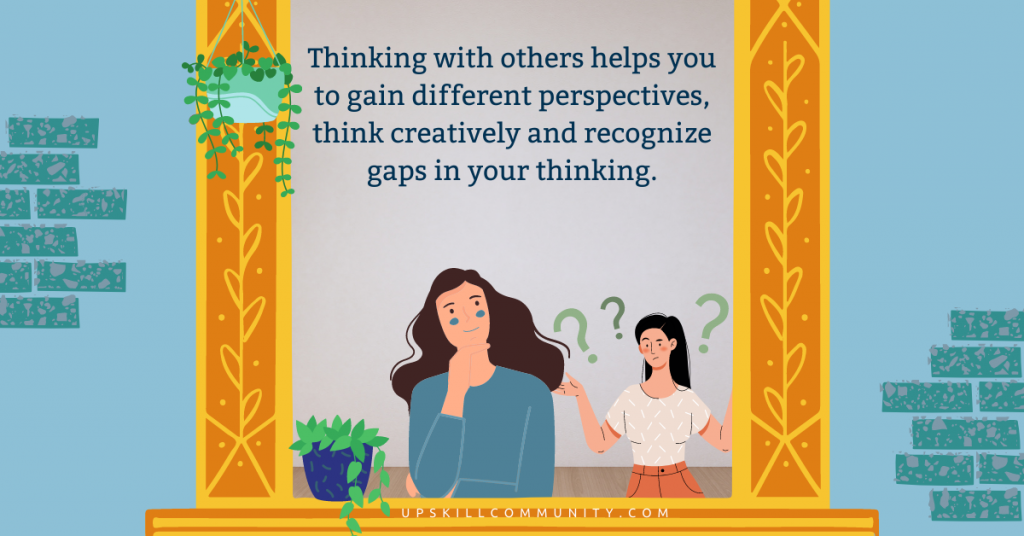
UpSkill: Strategies for Improving Your Thinking. Yes! You Can
In the previous blog post I shared a story with you on how automatic thinking impacts us, and we talked about the need for reflection. In this blog post I’m going to continue that conversation by encouraging you to shift and include more intentional thinking to complement our automatic ways of thinking as we proceed on our leadership journey.
So what I want to do is repeat the story I led off with in the previous episode, because it highlights the dangers of automatic thinking. Then, I’ll take us through some strategies for including more intentional thinking in our daily routine as leaders. Let’s dive in.
The story goes that a mother usually prepares ham for celebratory occasions. She would cut off both ends of the ham — and then put it in the baking pan — before baking it. Her daughter observes this behaviour and begins doing the same thing in her house when she grows up. Soon the daughter had her own child, an inquisitive little girl.
One day, as the mother prepared the ham, the little girl, Samantha, asks why her mom cut off the two sides.
The mom, for the first time, realized she didn’t know why.
The mom said, “I’m not so sure actually. My mom always did it this way, so that’s the way I do it too.”
“But why?” Samantha says.
So Samantha’s mom decided to call grandma to get to the bottom of things.
Grandma says, “Well dear. In the days when I was making the ham, the container we baked it in was very small. So I had to cut off the two ends to make it fit.”
Then the daughter looked at the size of the container she was using, which could fit two hams. Yet she’d continued the practice of cutting off the two ends.
Samantha asking why made her realize she was continuing a practice that was no longer relevant or necessary.
How do we intentionally think about our thinking? With busy lives, this is a task that may seem more difficult. We have too many tasks and too many people taking up our time and attention.
Where do we find time to think? Where do we find the time to get quiet, uninterrupted thinking time?
As leaders, we must find time.
As our world becomes more uncertain, more complex, those who do not commit time to think about their thinking will be at risk.
You want to:
1. Dedicate time for thinking.
This doesn’t mean a full day. It can be fifteen minutes a day or a half-hour a day. It just needs to be your practice, your discipline.
How do you think? Do you think with music in the background? With white noise? With a good view?
What do you need in place? What are the ideal conditions?
What is the type of space that allows you to get into your mindset for thinking? What are the strategies that you use for thinking? How do you record the thoughts that come from your practice?
When is the quiet time you have? These are things we must think about. Do you have a notebook? Do you use electronic devices?
Do you mind-map? I am a mind-mapper. I always need a board to lay my thoughts out clearly in writing. If I’m on the go, I use the “Notes” app on my phone to catalogue my thoughts. That may not be you.
What works for you?
When I have a few minutes waiting for a doctor’s appointment, I take the time to think and review my notes.
Find the right system for you. Find the right system that allows you to identify any areas where you’re cutting off the ends of the ham when you don’t need to.
We’ve probably all had a moment of annoyance with a child that always asks “why?” Yet we can learn from that child. We must become more curious. Ask “why?” Challenge your assumptions. Embrace the member of your team that asks questions that can potentially improve your team’s work.
Don’t get stuck in cruise control; falling into old patterns because they offer familiarity or comfort.
This is the real work we have to do as leaders. Reflect, ask questions.
What if the opposite were true?
What else is possible?
2. Find a thinking partner. Who are you thinking with?
“A mind that feeds on its own soon becomes starved.”
It’s one of my favourite quotations, although I am not sure who to attribute it to.
You need to think on your own, but you must also think with others. We must be very adaptable and agile in our thinking.
I want to encourage you to think with others. When you think with others you are getting their perspectives.
You get to recognize the gaps in your own thinking and learn from others. We need to think with others to help us become more innovative, to help us problem solve, to help us become more creative.

We need to think with others to help us solve the complex problems in our world today. To help us deal with the complexity of leading and creating a culture of positivity and inclusion.
I want to encourage you to find a thinking partner. Get busy brainstorming and tinkering with your mindset. Explore, experiment.
Organize, reorganize, scrutinize.
Think about your own system for thinking. The frameworks you use. The models you use. How do you think? Think about your own process for thinking and think “Is my process taking me where I want to go with my thinking?”
“What do I need to modify in my process as I develop this as a practice, as a discipline, so that as a leader I have a structured way of thinking?”
You must also be able to shift out of this way of thinking if necessary, but it is important to start with a framework. In order to build something, you must have a foundation.
I want you to encourage you to think about the story about Samantha and the two ends of the ham. Think of the mother who never thought to question why she had been doing something the same way for years.
Are you thinking automatically? Is there another way to do things?




